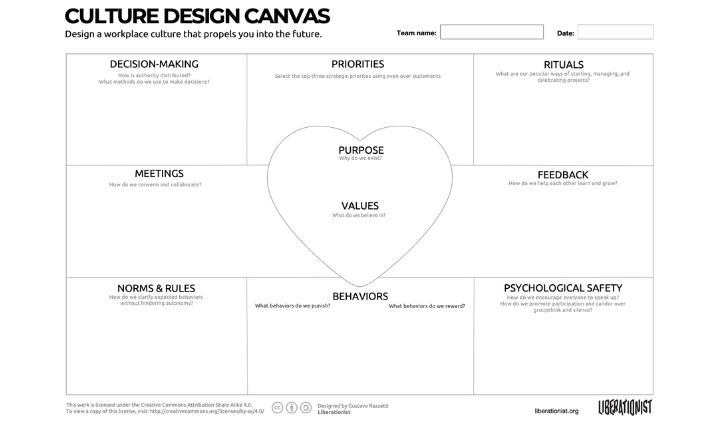Workplace culture is a powerful source of impact and productivity. According to Mckinsey, a strong workplace culture can increase business performance by 30-200%. Below, I outline how businesses and business leaders can design a performance promoting culture.
The workplace culture is not static. It changes in response to external and internal forces. Workplace culture brings people together and builds harmony. Workplace culture can be observed in multiple ways, e.g. leadership behaviours, manager-employee relationships, communication styles, levels of transparency and types of information and data circulating internally. It protects the system from “wrong people” and “wrong behaviours.”
How can we design a great workplace culture?
The Culture Design Canvas is a strategic tool that illustrates an organization’s culture on one page. It is comprised of 10 blocks; as follows:
???? The core (center): It is the basis of the organisation’s culture and represents the mentality that defines the company’s long-term direction. It contains 4 elements:
- Purpose
- Value
- Behaviours
- Priorities
???? Emotional culture (right): It explains how employees feel about their workplace and others. It includes 3 elements:
- Psychological safety
- Feedback
- Rituals
???? Rational Culture (left): It illustrates how basic things are managed and carried out. It includes 3 elements:
- Decision Making
- Meetings
- Norms and rules
The culture design canvas can be used in three ways:
- to map the current state of culture,
- to design a new culture,
- or to improve an existing workplace culture.
The culture design canvas is a visual tool that simply illustrates the current or targeted culture on one page. It is also used to build an image that everyone can understand, have a common language, and uncover areas for development. When the current culture is mapped out, it is easier for employees to understand what an organization stands for. It also helps to identify the gaps between the current state and the targeted culture.
What are some top tips for using the Culture Design Canvas?
- The Whole vs. the Part:The Culture Design Canvas can be used as a whole to build the corporate culture or individual blocks can be used to improve part of the culture. It can also be used to map the culture of teams or departments. Mapping the culture of teams and departments is important as subcultures can be compared with the culture of the organization. In mapping out subcultures, top management may discover some good and effective things that can be cascaded to the whole organisation.
- Allow Time: When mapping the current state culture, avoid rushing to fill in the ten blocks at once. The mapping process should be done strategically to better understand what the current culture is as data is collected and documented. The process of ensuring the authenticity of the core is necessary because the rest of the blocks are built on the core.
- Deliberating from the Core: The mapping process should start from the core (center). It is important to ensure that the data in it is accurate, correct, and reflects reality before starting with the other blocks. The aim of mapping a culture design canvas is to illustrate the true reality of what an organization’s culture is. Everyone who participates in filling the canvas must give real information and not what they aspire for or imagine the culture is based on their thinking.
- Inclusion & Diversity: It is necessary to involve different individuals from the organisation in mapping the culture and get them to work as a team to build the canvas.
- Importance of Iteration: It may take several iterations to reach the organisation’s final culture design canvas. Do not rely that the culture design canvas is finished after being completed for the first time. You may need a second, third, and fourth iteration in order to reach a culture design canvas that accurately reflects the organisation culture.
- Clarity & Simplicity: When drawing a culture design canvas make sure it is clear, consistent, and simple.


